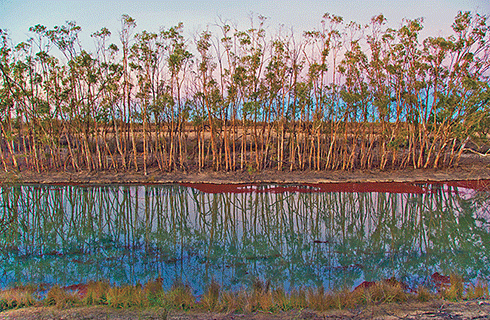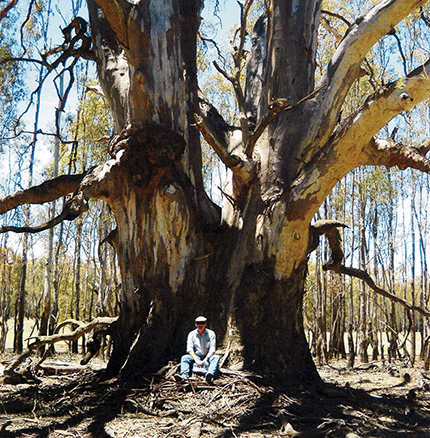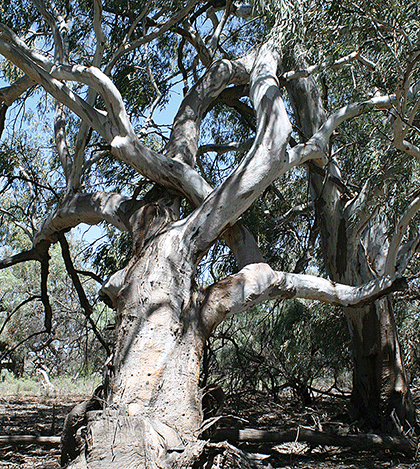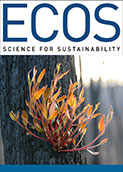
|
Published: 11 August 2014
Tree of life: the story of our river red gum
Flooded Forest and Desert Creek: Ecology and History of the River Red Gum by Matthew Colloff explores the cultural importance of one of Australia’s most iconic trees, the river red gum. Central to the book is an exploration of our cultural, scientific and spiritual connections with Eucalyptus camaldulensis. Author Matthew Colloff talks to ECOS writer, Beth Askham.

|
|
A young, even-aged stand of river red gums at sunset, Chowilla Floodplain. Credit:
Ian Overton
|
Flooded Forest and Desert Creek is divided into three parts: the unfolding forest, forces of change, and the move from exploitation to conservation and multiple values. How did this structure develop?
It’s more than the story of a tree; it’s the story of the landscape told through the history of the river red gum. Once I had decided to tell this story, the structure of the book shaped itself into these three parts.
Everything you do in environmental science is political, everything involves people and if you stick to the science you only end up telling a fraction of the story. People are part of the landscape and are the reason why these trees are important to us. The landscape tells us who we are – that’s the main message I was trying to convey.
In part one, I wrote about how the river red gum floodplains came to be. This part also includes the taxonomy and life history of the river red gum.
This led to the stories of landscape change in part two, including the impacts of European settlement and how this unfolded in the timber towns of the Riverina in southern New South Wales and northern Victoria. Trying to do that in a way that is balanced and non-partisan was a real challenge.
The third part was the most pleasurable but the most challenging to write – especially about ‘river red gum consciousness’ – it was not anything I had done before.
You describe ‘river red gum consciousness’ as a shift in Australia’s land management from wholesale exploitation to conservation and wise-use management. Can you tell us a little more about that term?
This came out of an idea that was sparked by a colleague and old mate, Steve Morton. He said ‘you have got to come to Alice Springs and see the river red gums here’. So I went. I knew that river red gums were important to people in the Murray-Darling Basin but I didn’t have the contrast of how they were also important to people in central Australia. Seeing this difference gave me the inspiration to write about the diverse relationships people have with these trees and how these relationships and peoples’ consciousness can change.
As a starting point, I was looking for a model of how our relationship with landscape unfolds. The best thing I found was by Brian Elliot in The Landscape of Australian Poetry. He separated the awareness of the human consciousness of landscape into stages: What does a place looks like? How does life arrange itself? How does this place influence people? What impact do people have on place? What spiritual values emerge? I thought that this was great model for this book and I have used it throughout.
The river red gum consciousness chapter depicts art and literature through these different categories and how those different phases affect people. Art provided a good framework to talk about this change, as art reminds us of our connection with place.
Painters such as Lin Onus see landscape as metaphor, landscape as a puzzle. Others, such as Hans Heysen showed how people have changed this landscape.

|
|
Matthew Colloff with a veteran river red gum at Barmah Forest during the Millennium Drought, 2007. Credit:
Kim Pullen
|
In CSIRO’s Christian labs in Black Mountain, Canberra, there is the beautiful and inspiring Land Research Mural by Robert Ingpen. Robert used to work for CSIRO as a communicator in the 1960s. The mural he painted was a communication tool showing the linkages of different elements of land systems science. I met Robert in 2012 when he came to Canberra to touch up and repair his mural. He put me onto his book Imprints of Generations: The Progress of Conservation in Australia. He had also used Brian Elliot’s ‘word model’ for his narrative. I owe Robert a huge debt of gratitude, because in that book he stressed the importance of regarding heritage values and environmental conservation as a unified concept. Placing people in landscape was central to Robert’s mural.
There is also a story I tell about a friend of mine, Megan Humphries, who teaches primary school kids in Sydney. She said to me, ‘my year grade six class are doing a project about the Murray-Darling Basin and we have all this information – there is a good online site for kids. She added that the kids were really into it and talking about water trading and conservation and getting into water rights and equity.
What was really great is that they were also using I book that I featured in the consciousness chapter by W.L. Williams called Red Gum Bend, written in the 1943 and another from 1979 by Colin Thiele and illustrated by Robert Ingpen called River Murray Mary.
I thought that it’s amazing that kids in the city were totally enthralled by the Murray landscape and could develop a connection even though they don’t live there.
Do you feel hopeful about the future of river red gum forests?
I know that I would have felt very differently about the future of river red gum forests if I hadn’t gone to visit central Australia. What I see there is that the trees have contracted their range from millions of years of a drying climate and are now confined to a narrow strip along the rivers. They don’t form extensive forests like they do along the Murray, so people don’t have a timber commodity association with them that they did in south-eastern Australia. People view them differently. They are sacred. They provide a refuge for animals within an otherwise harsh and arid landscape.
That tough enduring relationship provides a model for how we can learn to view them under climate change. Our landscapes will alter.
There will be some river red gum floodplains that will transition to terrestrial ecosystems. How we value what will be left remains to be seen, but generally the rarer something is the more people will value it. Our relationship with that unfolding and changing landscape will develop accordingly. Being conscious of it and aware of it and no longer viewing it only as a resource to be exploited is the relationship we need to develop for the future.
A tree that stands for water and life is a tree that stands for hope and endurance.
Matthew Colloff is a principle Research Scientist with CSIRO Ecosystem Sciences. His interests are in how ecosystems work, how they are changing, and what we can do about managing them.




